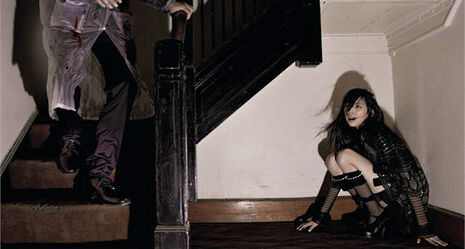Domestic violence is never ‘in Vogue’
The glamourisation of domestic abuse in the recent Vogue Italia shoot is shocking, argues Jilly Luke

Conducting fashion shoots in achingly poor taste is not exactly a new phenomenon. I give you the collected work of Terry Richardson as evidence. That, and the “bi-racial” themed America’s Next Top Model shoot. And indeed Vogue’s own contribution to the genre: pictures of ten year old Thylena Blondeau in full make-up and low cut dress. This month Vogue Italia are running a spread called ‘Horror Show’. In an interview with The Independent, Editor-In-Chief Franca Sozzani claims this is the magazine taking a stand against domestic violence. The models are as one might expect: tall, leggy and covered in blood.
In many ways, these photographs are no different from standard Vogue fare. There’s lots of long limbs, expensive clothes and interesting faces. But in one shot, the viewer’s eye moves seamlessly from the model’s red boots to her crimson dress to her Titian hair to the blood pooling under her head. The message is that the violence inflicted upon these women is part of their aesthetic. The overwhelming majority of anti domestic-violence adverts sponsored by governmental bodies and charities the world over make the physical realities of abuse clear. But here, the women aren’t covered in cigarette burns, they don’t have black eyes, and no one has been hurt in a way which disturbs the beauty of their body or the beauty of their clothes.
Domestic violence happens in all kinds of social settings, including ones as glitzy as the lifestyle which Vogue sells. The domestic violence which happens higher up the social chain is not less brutal or horrific than that which happens on council estates or semi-detached houses or in flats. Is it somehow not as bad to be stabbed to death with an Hattori knife?
Fashion shoots are inherently glamorous; that’s the point of them. And by extension, so are the acts of violence committed upon these bodies. Sozzani describes the roots of this shoot as in the “cinematic”, describing domestic violence as a “horror show”. Discussing it in these terms, as a theme for a fashion shoot or as a genre of film detaches domestic violence from the reality of what it is. Namely, (largely) men abusing, abusing, abusing and in too many cases going on to kill their partners.
Discussing domestic violence in anything but the starkest and most real of terms contributes to the dehumanisation of women. Our culture which is saturated by sexualised images of women’s bodies. To take one example from the middle of popular culture, the BBC’s Ripper Street had a dead woman on nearly every episode. They were normally prostitutes and frequently found naked and maimed. There is clearly an element of voyeurism at play here. We know the bodies of these women aren’t actually dead, and they are completely open to our gaze. This subtly establishes a link both between passivity and sexual appeal and sexualised bodies and bodies which are to be brutalised. This is highly dangerous in a society which prizes women for their aesthetic (read ‘sexual’) value.
Using objectified female bodies to “defend” women against domestic violence is ridiculous. Vogue are perpetuating the problem in order to solve it. And all the while, women are dying at the hands of abusive partners.
 Features / How sweet is the en-suite deal?13 January 2026
Features / How sweet is the en-suite deal?13 January 2026 Arts / Fact-checking R.F. Kuang’s Katabasis13 January 2026
Arts / Fact-checking R.F. Kuang’s Katabasis13 January 2026 News / SU sabbs join calls condemning Israeli attack on West Bank university13 January 2026
News / SU sabbs join calls condemning Israeli attack on West Bank university13 January 2026 Comment / Will the town and gown divide ever truly be resolved?12 January 2026
Comment / Will the town and gown divide ever truly be resolved?12 January 2026 News / 20 vet organisations sign letter backing Cam vet course13 January 2026
News / 20 vet organisations sign letter backing Cam vet course13 January 2026









